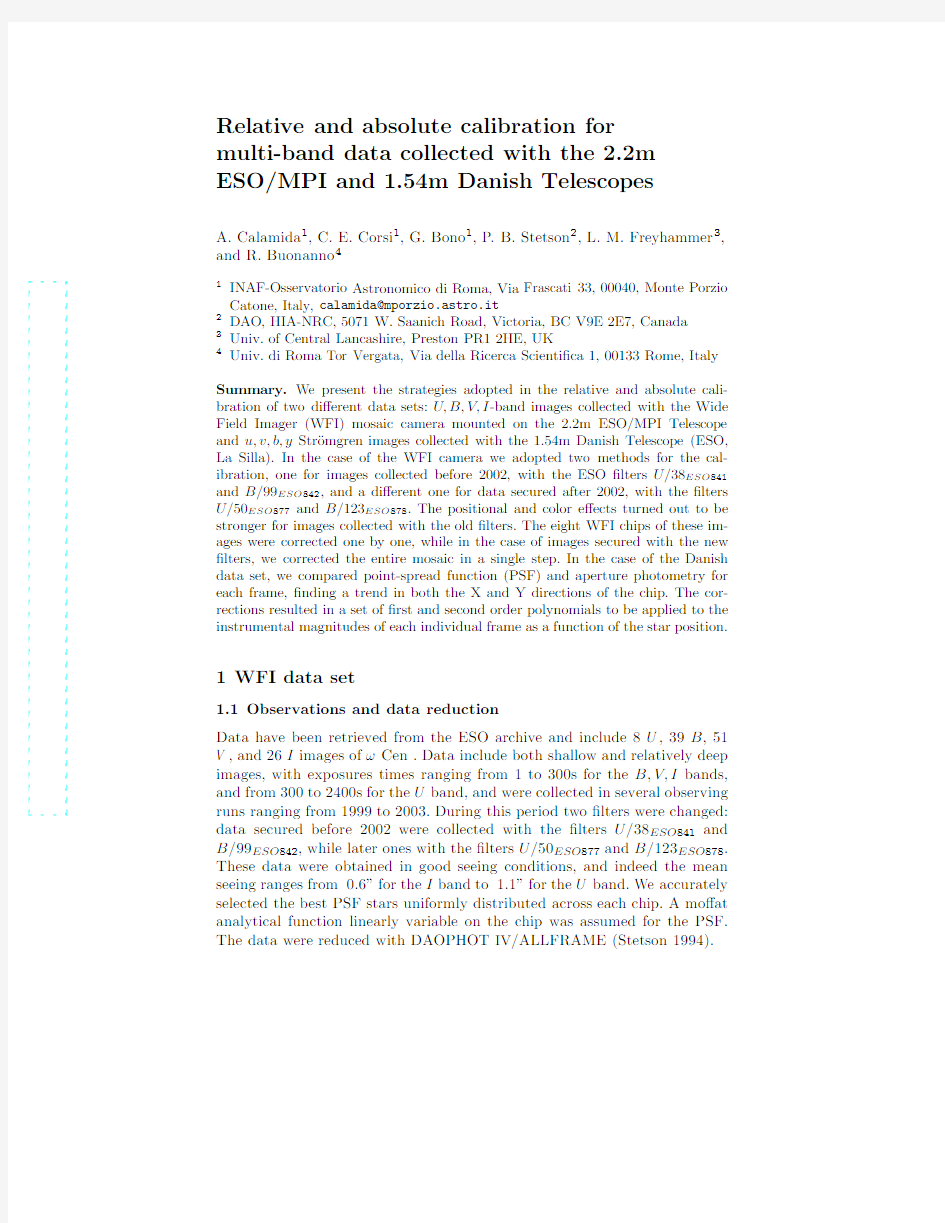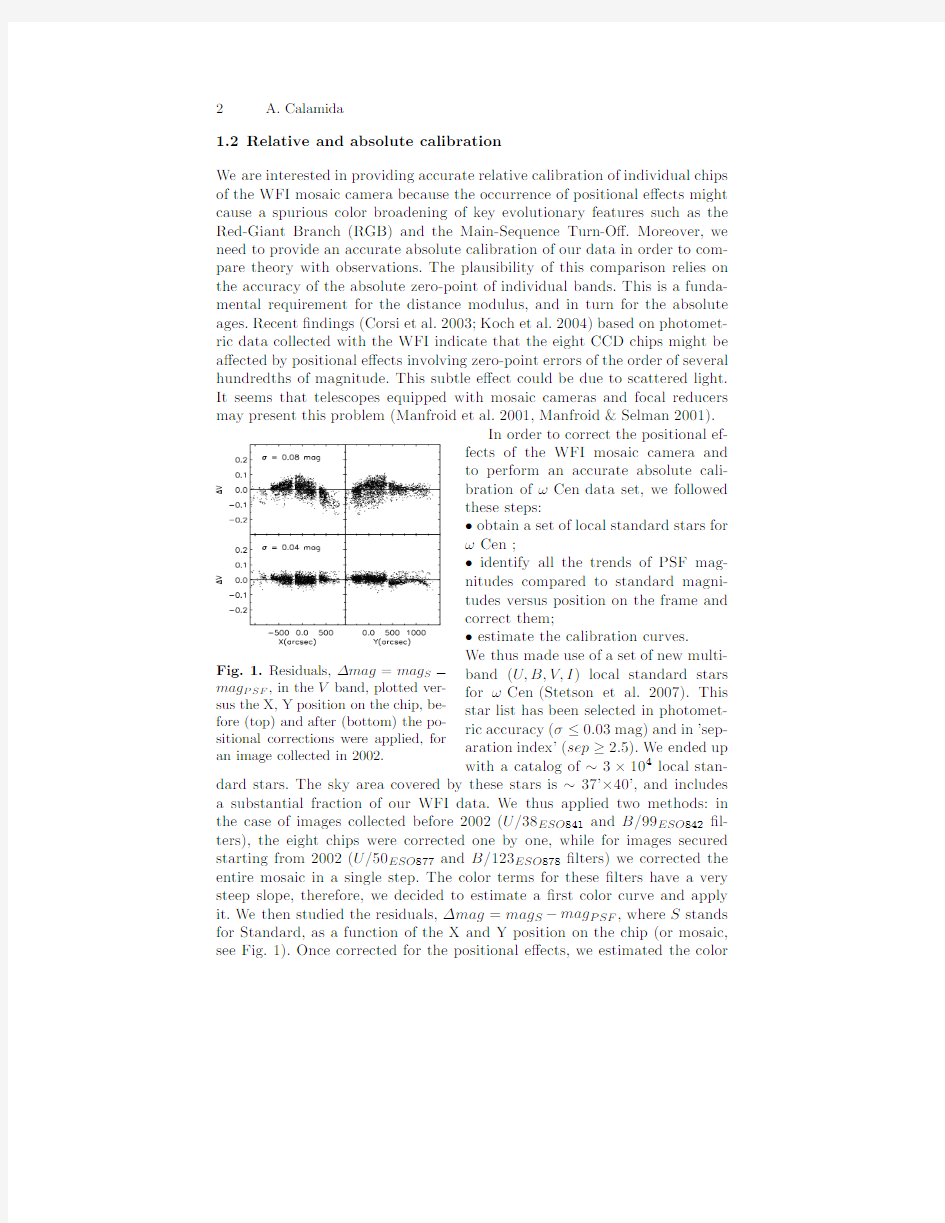Relative and absolute calibration for multi-band data collected with the 2.2m ESOMPI and 1.


a r
X
i
v
:08
1
.
6
9
3
v
1
[
a
s
t
r
o
-
p
h
]
4
J
a
n
2
8
Relative and absolute calibration for multi-band data collected with the 2.2m ESO/MPI and 1.54m Danish Telescopes A.Calamida 1,C.E.Corsi 1,G.Bono 1,P.B.Stetson 2,L.M.Freyhammer 3,and R.Buonanno 41INAF-Osservatorio Astronomico di Roma,Via Frascati 33,00040,Monte Porzio Catone,Italy,calamida@mporzio.astro.it 2DAO,HIA-NRC,5071W.Saanich Road,Victoria,BC V9E 2E7,Canada 3Univ.of Central Lancashire,Preston PR12HE,UK 4Univ.di Roma Tor Vergata,Via della Ricerca Scienti?ca 1,00133Rome,Italy Summary.We present the strategies adopted in the relative and absolute cali-bration of two di?erent data sets:U,B,V,I -band images collected with the Wide Field Imager (WFI)mosaic camera mounted on the 2.2m ESO/MPI Telescope and u,v,b,y Str¨o mgren images collected with the 1.54m Danish Telescope (ESO,La Silla).In the case of the WFI camera we adopted two methods for the cal-ibration,one for images collected before 2002,with the ESO ?lters U/38ESO 841and B/99ESO 842,and a di?erent one for data secured after 2002,with the ?lters U/50ESO 877and B/123ESO 878.The positional and color e?ects turned out to be stronger for images collected with the old ?lters.The eight WFI chips of these im-ages were corrected one by one,while in the case of images secured with the new ?lters,we corrected the entire mosaic in a single step.In the case of the Danish data set,we compared point-spread function (PSF)and aperture photometry for each frame,?nding a trend in both the X and Y directions of the chip.The cor-rections resulted in a set of ?rst and second order polynomials to be applied to the instrumental magnitudes of each individual frame as a function of the star position.1WFI data set 1.1Observations and data reduction Data have been retrieved from the ESO archive and include 8U ,39B ,51V ,and 26I images of ωCen .Data include both shallow and relatively deep images,with exposures times ranging from 1to 300s for the B,V,I bands,and from 300to 2400s for the U band,and were collected in several observing
runs ranging from 1999to 2003.During this period two ?lters were changed:data secured before 2002were collected with the ?lters U/38ESO 841and B/99ESO 842,while later ones with the ?lters U/50ESO 877and B/123ESO 878.These data were obtained in good seeing conditions,and indeed the mean seeing ranges from 0.6”for the I band to 1.1”for the U band.We accurately selected the best PSF stars uniformly distributed across each chip.A mo?at analytical function linearly variable on the chip was assumed for the PSF.The data were reduced with DAOPHOT IV /ALLFRAME (Stetson 1994).
2 A.Calamida
1.2Relative and absolute calibration
We are interested in providing accurate relative calibration of individual chips of the WFI mosaic camera because the occurrence of positional e?ects might cause a spurious color broadening of key evolutionary features such as the Red-Giant Branch(RGB)and the Main-Sequence Turn-O?.Moreover,we need to provide an accurate absolute calibration of our data in order to com-pare theory with observations.The plausibility of this comparison relies on the accuracy of the absolute zero-point of individual bands.This is a funda-mental requirement for the distance modulus,and in turn for the absolute ages.Recent?ndings(Corsi et al.2003;Koch et al.2004)based on photomet-ric data collected with the WFI indicate that the eight CCD chips might be a?ected by positional e?ects involving zero-point errors of the order of several hundredths of magnitude.This subtle e?ect could be due to scattered light. It seems that telescopes equipped with mosaic cameras and focal reducers may present this problem(Manfroid et al.2001,Manfroid&Selman2001).
In order to correct the positional
ef-
Fig.1.Residuals,?mag=mag S?mag P SF,in the V band,plotted ver-sus the X,Y position on the chip,be-fore(top)and after(bottom)the po-sitional corrections were applied,for an image collected in2002.fects of the WFI mosaic camera and to perform an accurate absolute cali-bration ofωCen data set,we followed these steps:
?obtain a set of local standard stars for ωCen;
?identify all the trends of PSF mag-nitudes compared to standard magni-tudes versus position on the frame and correct them;
?estimate the calibration curves.
We thus made use of a set of new multi-band(U,B,V,I)local standard stars forωCen(Stetson et al.2007).This star list has been selected in photomet-ric accuracy(σ≤0.03mag)and in’sep-aration index’(sep≥2.5).We ended up with a catalog of~3×104local stan-
dard stars.The sky area covered by these stars is~37’×40’,and includes a substantial fraction of our WFI data.We thus applied two methods:in the case of images collected before2002(U/38ESO841and B/99ESO842?l-ters),the eight chips were corrected one by one,while for images secured starting from2002(U/50ESO877and B/123ESO878?lters)we corrected the entire mosaic in a single step.The color terms for these?lters have a very steep slope,therefore,we decided to estimate a?rst color curve and apply it.We then studied the residuals,?mag=mag S?mag P SF,where S stands for Standard,as a function of the X and Y position on the chip(or mosaic, see Fig.1).Once corrected for the positional e?ects,we estimated the color
Calibration of multi-band data collected with ESO Telescopes3 term once again and applied it for the absolute zero-point calibration.This strategy relies on the assumption that the two corrections are independent, and there is no reason why this should not be the case.Fig.1shows the magnitude residuals in the V band plotted versus the X and Y positions on the frame,before and after the corrections were applied to an image collected in2002.The trend with the position is clear,non-linear,and stronger in the four outermost chips.A small residual trend on the position is still present in the external regions,where the lack of standard stars makes it di?cult to estimate the corrections.
We thus corrected the positional
ef-
Fig.2.Residuals,?mag=mag AP?mag P SF,in the u band,plotted ver-sus the X,Y position on the chip,be-fore(top)and after(bottom)the po-sitional corrections were applied.fects by?tting the?mag vs X/Y with second,third or fourth order polynomi-als,and we then estimated the calibra-tion curves for each set.We adopted a ?rst order polynomial to calibrate the V and the I bands as a function of the instrumental V?I color.In the case of the B band,we used a?rst order polynomial to calibrate the new?lter, B/123ESO878,and a third order one for the old?lter,B/99ESO842,as a function of the instrumental B?V color.Partic-ular attention has been paid to the U band calibration,either in the case of the old?lter,U/38ESO841,as well in the case of the new one,U/50ESO877.Hav-ing applied the positional corrections to
each set,we estimated a?rst color curve,a fourth order polynomial for U vs U?I.After applying this calibration curve,the U magnitudes still showed a residual trend as a function of the U magnitude and the U?I color.We thus corrected these trends with?rst and sixth order polynomials,respectively. The reason of these very complicated trends with colors is probably due to the shape of the old B and U?lters,which is quite di?erent from the shape of the standard Johnson?lters.
2Danish data set
A set of110u,v,b,y Str¨o mgren images centered onωCen were collected in 1999,with the2048×2048pixel Ford-Loral CCD mounted on the Danish Telescope.Data have been reduced with DAOPHOT IV/ALLFRAME,using an IDL procedure to accurately select the best PSF stars across each frame. We found that the b and the y frames present faint spurious re?ected images of bright stars.This e?ect causes a systematic decrease in the?ux measured by the PSF of bright stars and a systematic increase in the?ux of the faint
4 A.Calamida
neighbor stars.The e?ect strongly a?ects the photometry in crowded ?elds,resulting in a larger dispersion on the color-magnitude diagrams (CMDs),in particular in b versus b ?y .Furthermore,we investigated the presence of magnitude trends with X,Y position on the chip,comparing PSF and aperture photometry for each frame.The resulting e?ect changes from frame to frame,depending on the photometric band,and the magnitude di?erence from one edge to the other of the image can be as high as 0.15mag.The result is a set of ?rst and second order polynomials that correct the magnitudes of each individual frame as a function of the X and Y coordinates.Fig.2shows the magnitude residuals,?mag =mag AP ?mag P SF ,for the u band,before and after applying the corrections.
3Conclusions
We have presented the
relative
Fig.3.V,B ?V CMD for the entire WFI corrected catalog of ωCen .and absolute calibration strategies
applied to extended photometric cat-
alogues obtained with the 2.2m MPI
and the 1.54m Danish ESO Tele-
scopes.The photometry was per-
formed with DAOPHOT IV /
ALLFRAME in both cases,using a
linearly variable PSF across the im-
ages.In spite of the attention paid
in selecting PSF stars uniformly dis-
tributed in the frame,we found a
systematic error depending on the
position of the stars in the image,
when comparing instrumental to stan-
dard magnitudes.This e?ect might be due to problems in adapting the analytical PSF to variations across the image or to intrinsic problems of the optical system.Therefore,in order to perform an accurate relative and abso-lute calibration it is useful to check for the presence of a positional dependence of photometric errors.This is particularly recommended when dealing with telescopes equipped with focal reducers and mosaic cameras.
References
1.
Corsi,C.E.,et al.2003,Mem.SAIT,74,8842.
Koch,A.,Grebel,E.,Odenkirchen,M.,Caldwell,J.A.2004,Msngr,115,373.
Manfroid,J.,Royer,P.,Rauw,G.,Gosset,E.2001,ASPC,238,3734.
Manfroid,J.,Selman,S.2001,Msngr,104,165.
Stetson,P.B.,1994,PASP,106,2506.Stetson,P.B.,et al.2007,in preparation
